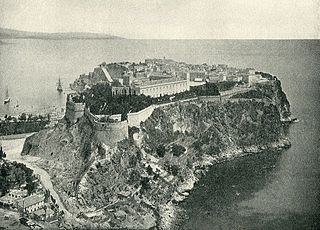
The early history of Monaco is primarily concerned with the protective and strategic value of the Rock of Monaco, the area's chief geological landmark, which served first as a shelter for ancient peoples and later as a fortress. Part of Liguria's history since the fall of the Roman Empire, from the 14th to the early 15th century the area was contested for primarily political reasons. Since that point, excepting a brief period of French occupation, it has remained steadily under the control of the House of Grimaldi.
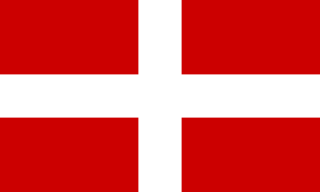
Savoy is a cultural-historical region in the Western Alps. Situated on the cultural boundary between Occitania and Piedmont, the area extends from Lake Geneva in the north to the Dauphiné in the south and west and to the Aosta Valley in the east.

Liguria is a region of north-western Italy; its capital is Genoa. Its territory is crossed by the Alps and the Apennines mountain range and is roughly coextensive with the former territory of the Republic of Genoa. Liguria is bordered by France to the west, Piedmont to the north, and Emilia-Romagna and Tuscany to the east. It rests on the Ligurian Sea, and has a population of 1,557,533. The region is part of the Alps–Mediterranean Euroregion.

The Ligures or Ligurians were an ancient people after whom Liguria, a region of present-day north-western Italy, is named.

The Republic of Genoa was a medieval and early modern maritime republic from the years 1099 to 1797 in Liguria on the northwestern Italian coast. During the Late Middle Ages, it was a major commercial power in both the Mediterranean and Black Sea. Between the 16th and 17th centuries, it was one of the major financial centres in Europe.

Apennins was a department of the First French Empire of 1805-1814 in present-day Italy. Named after the Apennine Mountains, it originated on 6 June 1805, after France had directly annexed the Ligurian Republic on 4 June 1805. Its capital was Chiavari.

The Ligurian Republic or Republic of Liguria was a French client republic formed by Napoleon on 14 June 1797. It consisted of the old Republic of Genoa, which covered most of the Ligurian region of Northwest Italy, and the small Imperial fiefs owned by the House of Savoy inside its territory. Its first Constitution was promulgated on 22 December 1797, establishing a directorial republic. The directory was deposed on 7 December 1799 and the executive was temporarily replaced by a commission. In 1802, a doge was nominated for a 5-year term, according to the second Constitution imposed by Napoleon, and a Senate was established.

Ligurian or Genoese is a Gallo-Italic language spoken primarily in the territories of the former Republic of Genoa, now comprising the area of Liguria in Northern Italy, parts of the Mediterranean coastal zone of France, Monaco, the village of Bonifacio in Corsica, and in the villages of Carloforte on San Pietro Island and Calasetta on Sant'Antioco Island off the coast of southwestern Sardinia. It is part of the Gallo-Italic and Western Romance dialect continuum. Although part of Gallo-Italic, it exhibits several features of the Italo-Romance group of central and southern Italy. Zeneize, spoken in Genoa, the capital of Liguria, is the language's prestige dialect on which the standard is based.

Albissola Marina is a comune (municipality) in the Province of Savona in the Italian region Liguria, located about 35 kilometres (22 mi) west of Genoa and about 4 kilometres (2.5 mi) northeast of Savona.
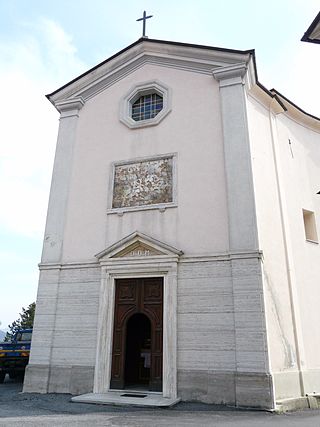
Bormida, with a population of 453 spread over an area of 22.4 square kilometres (8.6 sq mi), is a rural municipality of the Province of Savona in the Italian region Liguria. The municipality is a member of the Comunità Montana Alta Val Bormida. On May 11, 2017 it was reported that due to a declining population the town's mayor Daniele Galliano recommended a proposal to the Ligurian regional government, and not a confirmed measure, but that it hopes to enact the bonus in 2018 of offering €2,000 ($2,175) and very low rents starting at $50 per month for anyone willing to move there.

Cairo Montenotte is a comune (municipality) in the Province of Savona in Liguria, an Italian region located 50 kilometres (31 mi) west of Genoa and 20 kilometres (12 mi) northwest of Savona. Located in Val Bormida, it is a member of the Comunità Montana Alta Val Bormida. It is considered to be the main centre of Val Bormida and it has 12691 inhabitants. It is the fourth municipality in the province together with Savona, Albenga and Varazze, as well as the most popular municipality in Liguria among those without outlet on the sea. The municipal area is the biggest in the province behind Sassello, and the fifth in Liguria.

Sassello is a comune (municipality) in the Province of Savona in the Italian region Liguria, located about 58 kilometres (36 mi) west of Genoa and about 26 kilometres (16 mi) north of Savona in the northern side of the Ligurian Apennines. It is the birthplace of Blessed Chiara Badano.

Campo Ligure is a comune (municipality) in the Metropolitan City of Genoa in the Italian region Liguria, located about 37 kilometres (23 mi) northwest of Genoa.
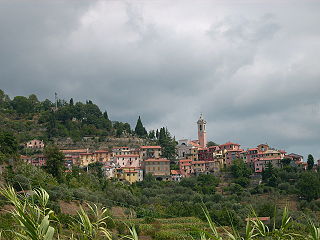
Castiglione Chiavarese is a comune (municipality) in the Metropolitan City of Genoa in the Italian region Liguria, located about 50 kilometres (31 mi) southeast of Genoa.

Moneglia is a comune (municipality) in the Metropolitan City of Genoa in the Italian region Liguria, located about 50 kilometres southeast of Genoa. It is a tourist resort on the Riviera di Levante. It is one of I Borghi più belli d'Italia.

Santa Margherita Ligure is a comune (municipality) in the Metropolitan City of Genoa in the Italian region Liguria, located about 35 kilometres (22 mi) southeast of Genoa, in the area traditionally known as Tigullio. It has a port, used for both tourism and fishing activities. Part of comune territory is included in the Regional Natural Park of Portofino. Santa Margherita Ligure borders the following municipalities: Camogli, Portofino, Rapallo.

Sori is a comune (municipality) in the Metropolitan City of Genoa in the Italian region Liguria, located about 17 kilometres (11 mi) southeast of Genoa. Together with Camogli, Pieve Ligure, Bogliasco, and Recco, it is part of the so-called Golfo Paradiso in the Riviera di Levante. Its economy is based on tourism and production of olives.
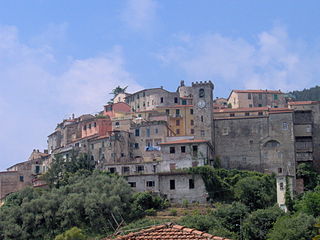
Ameglia is a comune (municipality) in the Province of La Spezia in the Italian region of Liguria, located about 90 kilometres (56 mi) southeast of Genoa and about 11 kilometres (7 mi) southeast of La Spezia.

Italian irredentism in Nice was the political movement supporting the annexation of the County of Nice to the Kingdom of Italy.

The Duchy of Genoa was a state consisting of the territories of the former Republic of Genoa. It was formed when the former territories of the republic were given to the Kingdom of Sardinia in 1815 as a result of the Congress of Vienna, and dissolved after the Perfect Fusion of 1848.